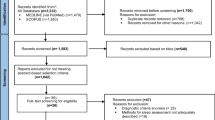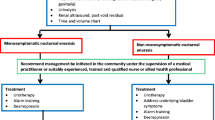Abstract
Purpose
Enuresis is a common sleep-related concern in school aged children that gradually decreases into adulthood. We performed a survey of sleep providers in order to assess their comfort level in managing patients with enuresis.
Methods
Survey participants were recruited via the Pedsleep listserv and sleep medicine program directors in the USA on basecamp application. The Pedsleep list includes a mixture of physicians, psychologists, and other sleep providers/researchers.
Results
Forty-two sleep providers completed the survey. Forty (95%) were board certified in sleep medicine, and 32 (76%) were board certified in pediatrics. Practice patterns for management of enuresis varied among respondents, with 69% who evaluate for possible contributions from other sleep disorders such as obstructive sleep apnea then refer for additional management. Nineteen (45%) respondents felt that they received inadequate or very inadequate training during their sleep fellowship for management of enuresis. While 83% of respondents worked in an academic medical center setting, none of their respective sleep clinics were the primary managing clinic at their own situation. Participants who endorsed their training as adequate/very adequate were significantly more likely to feel comfortable/very comfortable managing enuresis (90% vs 37.5%, p = 0.009).
Conclusions
A large percentage of sleep providers are lacking essential training to manage enuresis patients. These results suggest the need for additional educational initiatives in this area.
Similar content being viewed by others
Abbreviations
- REDCap:
-
Research Electronic Data Capture
- DDAVP:
-
1-Deamino-8-D-arginine vasopressin or desmopressin
References
Forsythe WI, Redmond A (1974) Enuresis and spontaneous cure rate. Study of 1129 enuretis. Arch Dis Childhood 49(4):259–263
Jarvelin MR, Vikevainen-Tervonen L, Moilanen I, Huttunen NP (1988) Enuresis in seven-year-old children. Acta Paediatr Scand 77(1):148–153
Yeung CK, Sihoe JD, Sit FK, Bower W, Sreedhar B, Lau J (2004) Characteristics of primary nocturnal enuresis in adults: an epidemiological study. BJU Int 93(3):341–345
Yeung CK, Sreedhar B, Sihoe JD, Sit FK, Lau J (2006) Differences in characteristics of nocturnal enuresis between children and adolescents: a critical appraisal from a large epidemiological study. BJU Int 97(5):1069–1073
Medicine AAoS (2014) International classification of sleep disorders. Am Acad Sleep Med
Neveus T, Fonseca E, Franco I et al (2020) Management and treatment of nocturnal enuresis-an updated standardization document from the International Children’s Continence Society. J Pediatr Urol 16(1):10–19
Brooks LJ, Topol HI (2003) Enuresis in children with sleep apnea. J Pediatr 142(5):515–518
Mota DM, Matijasevich A, Santos IS, Petresco S, Mota LM (2020) Psychiatric disorders in children with enuresis at 6 and 11 years old in a birth cohort. J Pediatr 96(3):318–326
Tsai HL, Chang JW, Chen MH, Jeng MJ, Yang LY, Wu KG (2020) Associations between psychiatric disorders and enuresis in Taiwanese children: a national population-based study. Clin Epidemiol 12:163–171
Rakowska-Silska M, Jobs K, Paturej A, Kalicki B (2020) Voiding disorders in pediatrician’s practice. Clin Med Insights Pediatr 14:1179556520975035
Longstaffe S, Moffatt ME, Whalen JC (2000) Behavioral and self-concept changes after six months of enuresis treatment: a randomized, controlled trial. Pediatrics 105(4 Pt 2):935–940
Dredla BK, Edgar L, Samman H et al (2021) Sleep Medicine Milestones 2.0: designed for our field. J Clin Sleep Med. 17(3):499–503
Acknowledgements
We thank the Medical Writing Center at Children's Mercy Kansas City for editing this manuscript.
Author information
Authors and Affiliations
Contributions
All authors have seen and approved the final manuscript.
Corresponding author
Ethics declarations
Ethics approval
All procedures performed in study involving human participants were in accordance with the ethical standards of the institutional research committee and with the 1964 Helsinki declaration and its later amendments or comparable ethical standards. This study was approved by institutional review board at Children’s Mercy (STUDY00001585).
Consent to participate
This type of study does not require informed consent.
Conflict of interest
The authors declare no competing interests.
Additional information
Publisher's note
Springer Nature remains neutral with regard to jurisdictional claims in published maps and institutional affiliations.
Rights and permissions
About this article
Cite this article
Al-Shawwa, B., Ingram, D.G. Enuresis and sleep fellowship education. Sleep Breath 26, 1377–1380 (2022). https://doi.org/10.1007/s11325-021-02518-6
Received:
Revised:
Accepted:
Published:
Issue Date:
DOI: https://doi.org/10.1007/s11325-021-02518-6




